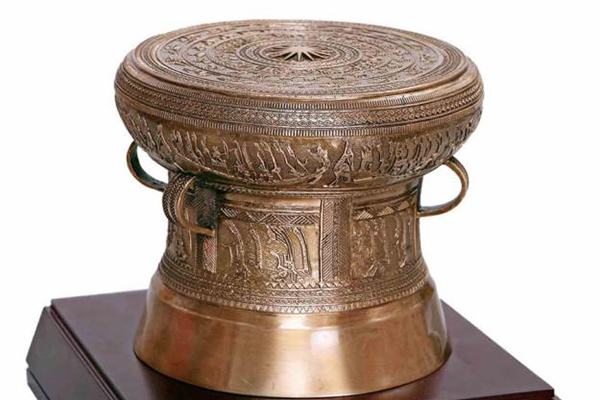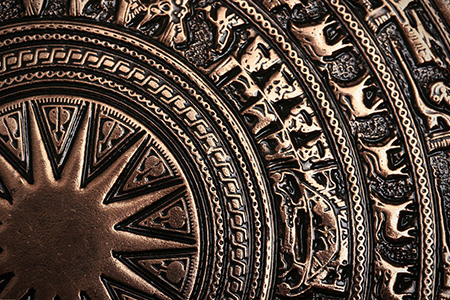The traveler getting out of Hanoi and going south takes National Highway One, the former mandarin road. He first passes the little town of Van Dien, the centre of Thuong Tin district on the outskirts of Hanoi. At kilometre 13, he notices by the roadside the Ngoc Hoi monument commemorating the lightning attack on Ngoc Hoi post which allowed the troop of King Quang Trung, head of the Tay Son peasant insurrection, to rush on to Hanoi where they routed the sino-manchu troops of occupation numbering 200,000 men in 1789. The aura crowning the most resounding military victory of old Vietnam is such that no one, even many Hanoians, will suspect that five kilometres away on the right-hand side of the monument there lies a place of repute in the history and culture of the country.
It is a small village with a population of 700 and the name Nguyet Anh, a rather poor locality whose inhabitants lives essentially from rice growing and has practically no sideline occupation. And yet few villages could contest its two claims to glory: the preservation of Bronze Age artefacts and the tradition of medieval doctors of humanities.
In December 1993, while a hole was being dug near the pond of the communal house in which to slake lime to be used in repair work, a boat-shaped tomb was uncovered containing a broken coffin with bone fragments and a whole lot of bronze weapons (spears, and disks. These artefacts date back to the 4th century BC. This corresponds to the time of the tutelary god being worshipped at the communal house standing close to the pond: Cong Ba Dai Vuong (His Highness the third brother of King Hung). His burial site is believed to be a mound some 500 metres away on the right- hand side of the communal house. Twice a year, in spring (12th day of the 2nd moon) and in autumn (12th day of the 5th moon) a solemn sacrifice is made to the god by the population.
The artefacts uncovered in Nguyet Ang village confirm the results of archaeological excavations conducted over four decades in several sites located both in the city itself and on its outskirts: from the second millennium BC to the beginning of the Christian era, the present territory of Hanoi saw the whole period of the Vietnamese Bronze Age up to the passage to the Iron Age: to witnessed in particular the blossoming of the Dong Son bronze culture.

Let us go back briefly to the prime origin of Hanoi whose history overlays that of the Vietnamese nation. The geological formation of the territory of Hanoi, lying in the heartland of the Song Hong (Red River) Delta, the cradle of the Viet (Bronze Age) is linked to that of the delta. The latter, tens of millions of years ago, was a deep gulf filled up with alluvium coming from the erosion of surrounding mountains and foothills (several dozen thousand years) and turned into an immense lagoon. Over several thousand years that lagoon eventually became a swampy area with numerous rivers, lakes and ponds, and also with vast stretches of forest teeming with mid beasts, elephants, crocodiles, turtles... Man through his patient labour shaped it into the Song Hong (Red River) Delta.
On the territory of present-day Hanoi, human presence as early as the Neolithic left visible traces up to the Bronze Age when the first two Viet states were born. Following a Chinese domination lasting more than a thousand years (2nd century BC-AD 10th century) the Viet people reconquered national independence and early in the 11th century established their capital in Thang Long, the city of the Soaring Dragon, Hanoi at present. A string of royal dynasties succeeded each other which, while subjected to strong Chinese influence, knew how to preserve the substratum of the Bronze Age, at the same enriching it with elements of Chinese culture.
The case of Nguyet Anh supplies convincing evidence of that. This small village has acquired a great reputation due to its cultural traditions highlighted by its many laureates to triennial competitions of the old regime. On the esplanade devoted to the cult of Confucius two square-shaped stone stele, erected in 1667 and 1876 respectively, bear the names of ten villagers honoured with the title of doctor of humanities, one of them a First Doctor (Trang Nguyen). One is surprised at the large number of laureates for many villages with six or seven times its population could not boast a single doctor, even a licentiate. To give an idea of the rigour of the triennial competitions, which opened the way to the mandarinate, let us cite a few figures in connection with the regional competition held in Hanoi in 1876 and 1879: out of 6,000 candidates there were selected 75 laureates 25 licentiates and 50 bachelors. The licentiates could present themselves at the doctoral competition held in the capital. The selection became ever tighter. The title of First Doctor was not always granted, and was abolished outright in the 19th century.
However, even more than the number of its doctors and mandarins, Nguyet Ang deserves our attention in another respect: the perennial character of the bronze culture, the foundation of our cultural identity, on which foreign elements have been grafted. The scholars, devoted though they were to Confucian ideas, continued the centuries-old cult reserved for a prince of the Bronze Age.



